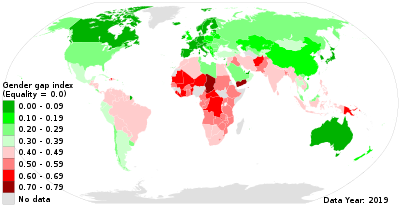
Back مؤشر عدم المساواة بين الجنسين Arabic Índex de desigualtat de gènere Catalan Index der geschlechtsspezifischen Ungleichheit German Δείκτης ανισότητας των φύλων Greek Índice de desigualdad de género Spanish Genero Desberdintasunaren Indizea Basque شاخص نابرابری جنسیتی Persian Indice d'inégalité de genre French Fihirisar Rashin Daidaiton Jinsi Hausa ジェンダー不平等指数 Japanese

The Gender Inequality Index (GII) is an index for the measurement of gender disparity that was introduced in the 2010 Human Development Report 20th anniversary edition by the United Nations Development Programme (UNDP). According to the UNDP, this index is a composite measure to quantify the loss of achievement within a country due to gender inequality. It uses three dimensions to measure opportunity cost: reproductive health, empowerment, and labor market participation. The new index was introduced as an experimental measure to remedy the shortcomings of the previous indicators, the Gender Development Index (GDI) and the Gender Empowerment Measure (GEM), both of which were introduced in the 1995 Human Development Report.
- ^ Nations, United (2020). "Human Development Report 2020 - Table 5: Gender Inequality Index". United Nations Development Programme. Retrieved 2021-01-22.